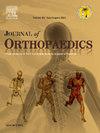Variability in the classification, management, and outcome reporting for avascular necrosis of the femoral head: A systematic review
IF 1.5
Q3 ORTHOPEDICS
引用次数: 0
Abstract
Introduction
There is no universally-utilized classification system for avascular necrosis of the femoral head (AVNFH), a debilitating condition that arises due to impaired blood supply resulting in cortical collapse. AVNFH may require early intervention to prevent irreversible damage leading to total hip arthroplasty. The purpose of this study is to assess the variability in classification, management, and outcomes reported in randomized controlled trials (RCTs) related to AVNFH.
Methods
PubMed, Embase, and Medline were queried for RCTs on the treatment of AVNFH (2010–2023). The number of patients, number of femoral heads, minimum follow-up, AVNFH classification system, treatment interventions, and outcome measures were extracted. Variability in classification, management approach, and reporting of outcomes was evaluated.
Results
A total of 30 RCTs met inclusion criteria, encompassing 1891 total patients. The mean number of patients in each study was 63 (SD = 41), with a mean minimum follow-up of 30 months (SD = 17). The Association Research Circulation Osseous classification system was utilized in 63 % (n = 19) of studies, Ficat and Arlet in 20 % (n = 6) of studies, Steinberg in 10 % (n = 3), Mitchell in 3 % (n = 1), and the China-Japan Friendship Hospital classifications in 3 % (n = 1). There were 61 treatment interventions, stratified into nine categories. Radiographic imaging was most commonly used to evaluate patients at follow-up.
Conclusion
There are a variety of classification systems, treatments, and outcome measures utilized in the literature to categorize and quantify AVNFH. The utilization of a universally-accepted classification system and standardized outcome reporting may help to ensure reproducibility and accuracy given a continued lack of consensus.
股骨头缺血性坏死的分类、治疗和预后报告的可变性:一项系统综述
股骨头缺血性坏死(AVNFH)是一种由于血液供应受损导致皮质塌陷而引起的衰弱性疾病,目前尚无普遍使用的分类系统。AVNFH可能需要早期干预,以防止导致全髋关节置换术的不可逆损伤。本研究的目的是评估与AVNFH相关的随机对照试验(rct)在分类、管理和结果方面的可变性。方法查询spubmed、Embase和Medline中2010-2023年AVNFH治疗的随机对照试验。提取患者数量、股骨头数量、最短随访时间、AVNFH分类系统、治疗干预措施和结局指标。评估了分类、管理方法和结果报告的可变性。结果30项rct符合纳入标准,共纳入1891例患者。每项研究的平均患者数为63例(SD = 41),平均最小随访时间为30个月(SD = 17)。63% (n = 19)的研究采用了协会研究循环骨组织分类系统,20% (n = 6)的研究采用了Ficat和Arlet分类系统,10% (n = 3)的研究采用了Steinberg分类系统,3% (n = 1)的研究采用了Mitchell分类系统,3% (n = 1)的研究采用了中日友好医院分类系统。共有61项治疗干预措施,分为9类。影像学是最常用的随访评估方法。结论文献中有多种分类系统、治疗方法和结果测量方法来对AVNFH进行分类和量化。在持续缺乏共识的情况下,使用普遍接受的分类系统和标准化的结果报告可能有助于确保再现性和准确性。
本文章由计算机程序翻译,如有差异,请以英文原文为准。
求助全文
约1分钟内获得全文
求助全文
来源期刊

Journal of orthopaedics
ORTHOPEDICS-
CiteScore
3.50
自引率
6.70%
发文量
202
审稿时长
56 days
期刊介绍:
Journal of Orthopaedics aims to be a leading journal in orthopaedics and contribute towards the improvement of quality of orthopedic health care. The journal publishes original research work and review articles related to different aspects of orthopaedics including Arthroplasty, Arthroscopy, Sports Medicine, Trauma, Spine and Spinal deformities, Pediatric orthopaedics, limb reconstruction procedures, hand surgery, and orthopaedic oncology. It also publishes articles on continuing education, health-related information, case reports and letters to the editor. It is requested to note that the journal has an international readership and all submissions should be aimed at specifying something about the setting in which the work was conducted. Authors must also provide any specific reasons for the research and also provide an elaborate description of the results.
 求助内容:
求助内容: 应助结果提醒方式:
应助结果提醒方式:


